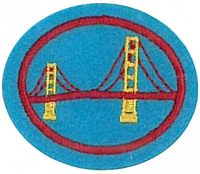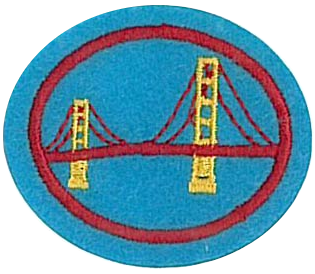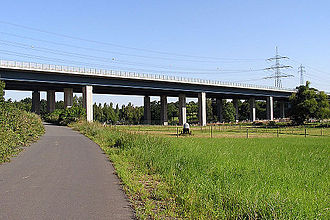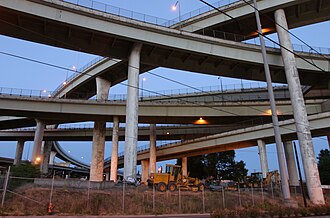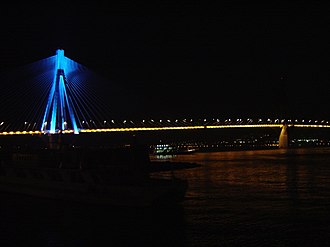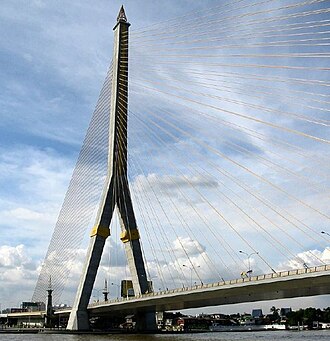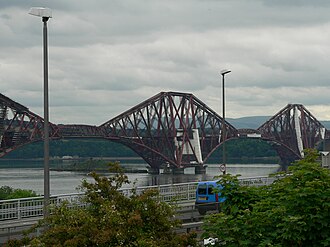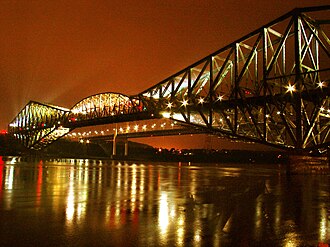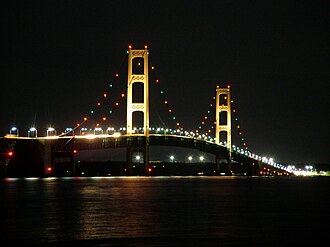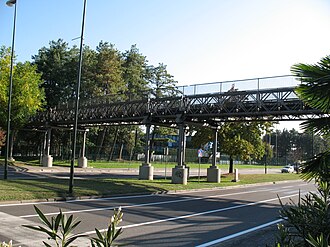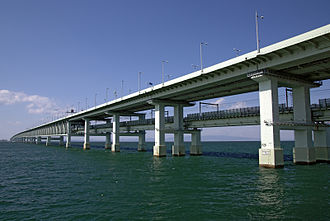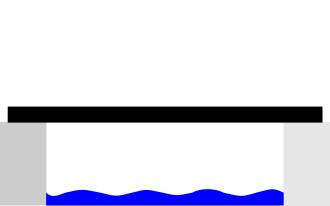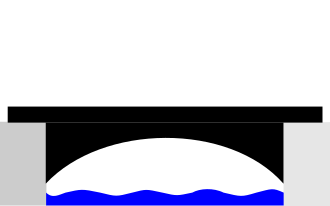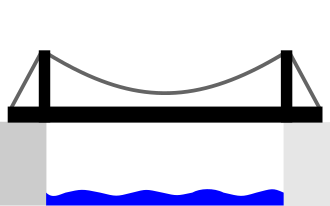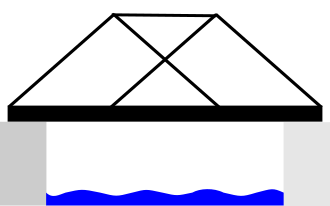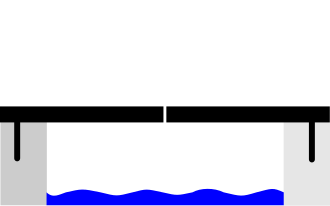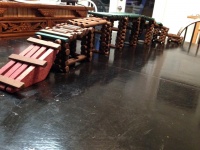Difference between revisions of "AY Honors/Bridges/Answer Key"
m |
|||
| (62 intermediate revisions by 6 users not shown) | |||
| Line 1: | Line 1: | ||
| − | {{ | + | {{HonorSubpage}} |
| + | <section begin="Body" /> | ||
| + | {{ansreq|page={{#titleparts:{{PAGENAME}}|2|1}}|num=1}} | ||
| + | <noinclude><translate><!--T:121--> | ||
| + | </noinclude> | ||
| + | <!-- 1. Define the following terms: --> | ||
| + | <noinclude></translate></noinclude> | ||
| + | {{ansreq|page={{#titleparts:{{PAGENAME}}|2|1}}|num=1a}} | ||
| + | <noinclude><translate><!--T:122--> | ||
| + | </noinclude> | ||
| + | A structure built to span a valley, road or railroad, body of water, or other physical obstacle, for the purpose of providing passage over the obstacle. | ||
| − | = | + | <!--T:3--> |
| − | + | <noinclude></translate></noinclude> | |
| − | + | {{CloseReq}} <!-- 1a --> | |
| − | + | {{ansreq|page={{#titleparts:{{PAGENAME}}|2|1}}|num=1b}} | |
| − | + | <noinclude><translate><!--T:123--> | |
| − | + | </noinclude> | |
| − | + | A bridge that carries water. Popular before we had electric pumps. Lots of [https://en.wikipedia.org/wiki/Aqueduct_(bridge) interesting photos here]. | |
| − | + | [[Image:MonroeStreetBridgea.jpg|right|thumb|550px|Falsework centering in the center arch of Monroe Street Bridge, Spokane, Washington. 1911.]] | |
| − | ==2 | + | <!--T:124--> |
| − | == | + | <noinclude></translate></noinclude> |
| + | {{CloseReq}} <!-- 1b --> | ||
| + | {{ansreq|page={{#titleparts:{{PAGENAME}}|2|1}}|num=1c}} | ||
| + | <noinclude><translate><!--T:125--> | ||
| + | </noinclude> | ||
| + | The temporary support scaffolding used during the construction of some types of bridges. | ||
| + | <noinclude></translate></noinclude> | ||
| + | {{CloseReq}} <!-- 1c --> | ||
| + | {{ansreq|page={{#titleparts:{{PAGENAME}}|2|1}}|num=1d}} | ||
| + | <noinclude><translate><!--T:126--> | ||
| + | </noinclude> | ||
| + | The downward pressure (usually vertical) that is applied to the supporting columns of a bridge design by the weight of the bridge materials as well as the traffic load that is on the bridge. | ||
| + | <noinclude></translate></noinclude> | ||
| + | {{CloseReq}} <!-- 1d --> | ||
| + | {{ansreq|page={{#titleparts:{{PAGENAME}}|2|1}}|num=1e}} | ||
| + | <noinclude><translate><!--T:127--> | ||
| + | </noinclude> | ||
| + | The tightening or pulling together force (usually horizontal or at an angle other than vertical) that helps to stabilize a bridge design, and transfers compression force back to the supports of a bridge design. | ||
| + | <noinclude></translate></noinclude> | ||
| + | {{CloseReq}} <!-- 1e --> | ||
| + | {{ansreq|page={{#titleparts:{{PAGENAME}}|2|1}}|num=1f}} | ||
| + | <noinclude><translate><!--T:128--> | ||
| + | </noinclude> | ||
| + | A movable bridge with a counterweight that continually balances the span throughout the entire upward swing in providing clearance for boat traffic. They are the most common type of movable bridge in existence because they open quickly and require relatively little energy to operate. Bascule is a french word. In English this is usually called a draw bridge. | ||
| + | [[Image:MovableBridge_draw.gif]] | ||
| + | <noinclude></translate></noinclude> | ||
| + | {{CloseReq}} <!-- 1f --> | ||
| + | {{ansreq|page={{#titleparts:{{PAGENAME}}|2|1}}|num=1g}} | ||
| + | <noinclude><translate><!--T:129--> | ||
| + | </noinclude> | ||
| + | A structure with enclosed sides and a roof that often has only a single lane, and typically is made of wood. Since wooden bridges tended to deteriorate rapidly from exposure to the elements, they only had a useful lifespan of nine years. Covering them protected their structural members, thus extending their life to 80 years or more. Though it would seem that covering them would also eliminate the need to plow them after snowstorms, they actually had to move snow onto them in winter so that sleighs could go through. Before automobiles, roads were compacted rather than plowed, and pulling a sleigh across an un-snowed deck would have been very difficult. | ||
| + | [[Image:Buchfart_-_Alte_Holzbr%C3%BCcke_1613_%C3%BCber_die_Ilm.jpg|200px|Buchfart - Alte Holzbrücke 1613]] | ||
| + | <!--T:130--> | ||
| + | <noinclude></translate></noinclude> | ||
| + | {{CloseReq}} <!-- 1g --> | ||
| + | {{CloseReq}} <!-- 1 --> | ||
| + | {{ansreq|page={{#titleparts:{{PAGENAME}}|2|1}}|num=2}} | ||
| + | <noinclude><translate><!--T:131--> | ||
| + | </noinclude> | ||
| + | <!-- 2. Describe these six main types of bridge design and give two examples of each: --> | ||
| + | <noinclude></translate></noinclude> | ||
| + | {{ansreq|page={{#titleparts:{{PAGENAME}}|2|1}}|num=2a}} | ||
| + | <noinclude><translate><!--T:132--> | ||
| + | </noinclude> | ||
| + | |||
| + | <!--T:5--> | ||
[[File:Bridge Alcantara.JPG|thumb|300px|Alcantara Bridge]] | [[File:Bridge Alcantara.JPG|thumb|300px|Alcantara Bridge]] | ||
| − | Arch-shaped bridges that have abutments at each end. Arch bridges work by transferring the weight of the bridge and its loads partially into a horizontal thrust restrained by the abutments at either side. | + | <!--T:6--> |
| − | The greatest bridge builders of antiquity were the ancient Romans. The Romans built arch bridges and aqueducts that could stand in conditions that would damage or destroy earlier designs. | + | Arch-shaped bridges that have abutments at each end. Arch bridges work by transferring the weight of the bridge and its loads partially into a horizontal thrust restrained by the abutments at either side. A viaduct (a long bridge) may be made from a series of arches, although other more economical structures are typically used to span a long distance today. |
| + | The greatest bridge builders of antiquity were the ancient Romans. The Romans built arch bridges and aqueducts that could stand in conditions that would damage or destroy earlier designs. An example of one that still stands today is the Alcantara Bridge in Spain. | ||
| − | The earliest known arch bridges were built by the Greeks and include the Arkadiko Bridge. | + | <!--T:7--> |
| + | The earliest known arch bridges were built by the Greeks and include the Arkadiko Bridge. | ||
| − | Dubai in the United Arab Emirates is currently building the Sheikh Rashid bin Saeed Crossing which is scheduled for completion in 2012. | + | <!--T:133--> |
| + | Dubai in the United Arab Emirates is currently building the Sheikh Rashid bin Saeed Crossing which is scheduled for completion in 2012. When completed, it will be the largest arch bridge in the world. | ||
{{clear}} | {{clear}} | ||
| − | == | + | <noinclude></translate></noinclude> |
| + | {{CloseReq}} <!-- 2a --> | ||
| + | {{ansreq|page={{#titleparts:{{PAGENAME}}|2|1}}|num=2b}} <!--T:8--> | ||
| + | <noinclude><translate><!--T:134--> | ||
| + | </noinclude> | ||
[[File:Bundesautobahn 5 Urselbachtal.jpg|thumb|300px|Beam bridge in Germany]] | [[File:Bundesautobahn 5 Urselbachtal.jpg|thumb|300px|Beam bridge in Germany]] | ||
[[File:FremontBridgeApproach.jpg|thumb|300px|The northern approach ramps of the Fremont Bridge where it intersects with Interstate 5.]] | [[File:FremontBridgeApproach.jpg|thumb|300px|The northern approach ramps of the Fremont Bridge where it intersects with Interstate 5.]] | ||
| − | The beam bridge is the simplest kind of bridge today. | + | <!--T:9--> |
| + | The beam bridge is the simplest kind of bridge today. The earliest beam bridges were simple logs that sat across streams and similar simple structures. In modern times, beam bridges are more commonly made from shallow steel “I” beams, box girders, reinforced concrete, or post-tensioned concrete. | ||
| − | Like most bridges that are characterized by how they are supported, beam bridges consist of one horizontal beam with 2 supports, usually on either end. | + | <!--T:10--> |
| + | Like most bridges that are characterized by how they are supported, beam bridges consist of one horizontal beam with 2 supports, usually on either end. Weight on top of the beam pushes straight down on the piers at either end of the bridge. | ||
| + | <!--T:11--> | ||
Examples include most highway overpasses, and any single log bridge. | Examples include most highway overpasses, and any single log bridge. | ||
{{clear}} | {{clear}} | ||
| − | == | + | <!--T:135--> |
| + | <noinclude></translate></noinclude> | ||
| + | {{CloseReq}} <!-- 2b --> | ||
| + | {{ansreq|page={{#titleparts:{{PAGENAME}}|2|1}}|num=2c}} <!--T:12--> | ||
| + | <noinclude><translate><!--T:136--> | ||
| + | </noinclude> | ||
[[File:The amazing bridge that spans the Yangtze River-edit.jpg|thumb|300px|Sutong Bridge over the Yangtze River]] | [[File:The amazing bridge that spans the Yangtze River-edit.jpg|thumb|300px|Sutong Bridge over the Yangtze River]] | ||
| − | [[File:Antirio | + | [[File:Rio Antirio dsc06353.jpg|thumb|300px|Rio-Antirio Bridge in Greece (fan shaped)]] |
[[File:Rama VIII Bridge, Thailand-edit.jpg|thumb|300px|Rama VIII Bridge in Thailand (harp shaped)]] | [[File:Rama VIII Bridge, Thailand-edit.jpg|thumb|300px|Rama VIII Bridge in Thailand (harp shaped)]] | ||
| − | A bridge that consists of one or more columns (normally referred to as towers or pylons), with cables supporting the bridge deck. | + | <!--T:13--> |
| + | A bridge that consists of one or more columns (normally referred to as towers or pylons), with cables supporting the bridge deck. Like suspension bridges, cable-stayed bridges are held up by cables. However, in a cable-stayed bridge, less cable is required and the towers holding the cables are proportionately shorter. The first known cable-stayed bridge was designed in 1784 by C. T. Loescher. | ||
| − | + | <!--T:14--> | |
| + | On April 12, 2013 the Russky Bridge in Vladivostok, Russia with its 1,104 meters (3,622 ft) span replaced the Sutong Bridge over the Yangtze River in China as the world's longest cable-stayed bridge. | ||
| − | + | <!--T:15--> | |
| + | The second or third longest cable-stayed bridge in the western hemisphere is the Port Mann Bridge near Vancouver, BC. At 10 lanes (65m wide) it is the world's widest long span bridge of any type. | ||
| − | Compared to other bridge types, the cable-stayed is optimal for spans longer than typically seen in cantilever bridges and shorter than those typically requiring a suspension bridge. | + | <!--T:16--> |
| + | There are two major classes of cable-stayed bridges: In a harp design, the cables are made nearly parallel by attaching cables to various points on the tower(s) so that the height of attachment of each cable on the tower is similar to the distance from the tower along the roadway to its lower attachment. In a fan design, the cables all connect to or pass over the top of the tower(s). | ||
| + | |||
| + | <!--T:17--> | ||
| + | Compared to other bridge types, the cable-stayed is optimal for spans longer than typically seen in cantilever bridges and shorter than those typically requiring a suspension bridge. This is the range in which cantilever spans would rapidly grow heavier if they were lengthened, and in which suspension cabling does not get more economical were the span to be shortened. | ||
{{clear}} | {{clear}} | ||
| − | == | + | <!--T:137--> |
| + | <noinclude></translate></noinclude> | ||
| + | {{CloseReq}} <!-- 2c --> | ||
| + | {{ansreq|page={{#titleparts:{{PAGENAME}}|2|1}}|num=2d}} <!--T:18--> | ||
| + | <noinclude><translate><!--T:138--> | ||
| + | </noinclude> | ||
[[File:Forth bridges 2005-06-17 04.jpg|thumb|300px|Forth Rail Bridge]] | [[File:Forth bridges 2005-06-17 04.jpg|thumb|300px|Forth Rail Bridge]] | ||
[[File:Photo 149.jpg|thumb|300px|Quebec Bridge, Quebec, Canada]] | [[File:Photo 149.jpg|thumb|300px|Quebec Bridge, Quebec, Canada]] | ||
| − | A bridge built using cantilevers, structures that project horizontally into space, supported on only one end. | + | A bridge built using cantilevers, structures that project horizontally into space, supported on only one end. For small footbridges, the cantilevers my be simple beams; however, large cantilever bridges designed to handle road or rail traffic use trusses built from structural steel, or box girders built from pre-stressed concrete. The steel truss cantilever bridge was a major breakthrough when first put into practice, as it can span distances of over 1,500 feet, and can be more easily constructed at difficult crossings by virtue of using little or no falsework. |
| − | The most famous early cantilever bridge is the Forth Rail Bridge. | + | <!--T:19--> |
| + | The most famous early cantilever bridge is the Forth Rail Bridge Firth of Forth in the east of Scotland constructed from 1882-1890. This bridge held the record for longest span in the world for 17 years. | ||
{{clear}} | {{clear}} | ||
| − | == | + | <!--T:139--> |
| + | <noinclude></translate></noinclude> | ||
| + | {{CloseReq}} <!-- 2d --> | ||
| + | {{ansreq|page={{#titleparts:{{PAGENAME}}|2|1}}|num=2e}} <!--T:20--> | ||
| + | <noinclude><translate><!--T:140--> | ||
| + | </noinclude> | ||
| + | <!--T:21--> | ||
[[File:Akashi Bridge.JPG|thumb|300px|Akashi-Kaikyo Bridge in Japan]] | [[File:Akashi Bridge.JPG|thumb|300px|Akashi-Kaikyo Bridge in Japan]] | ||
[[File:Mackinac Bridge Mod 1.jpg|thumb|300px|Mackinac Bridge in Michigan]] | [[File:Mackinac Bridge Mod 1.jpg|thumb|300px|Mackinac Bridge in Michigan]] | ||
| − | A type of bridge in which the deck (the load-bearing portion) is hung below suspension cables on vertical suspenders. | + | A type of bridge in which the deck (the load-bearing portion) is hung below suspension cables on vertical suspenders. While modern bridges of this type date from the early 19th century, earlier bridges without vertical suspenders (simple suspension bridges) date from the 7th century in Central America. |
| − | This type of bridge has cables suspended between towers, plus vertical suspender cables that carry the weight of the deck below, upon which traffic crosses. | + | <!--T:22--> |
| + | This type of bridge has cables suspended between towers, plus vertical suspender cables that carry the weight of the deck below, upon which traffic crosses. This arrangement allows the deck to be level or to arc upward for additional clearance. Like other suspension bridge types, this type often is constructed without falsework. | ||
| − | The suspension cables must be anchored at each end of the bridge, since any load applied to the bridge is transformed into a tension in these main cables. | + | <!--T:23--> |
| + | The suspension cables must be anchored at each end of the bridge, since any load applied to the bridge is transformed into a tension in these main cables. The main cables continue beyond the pillars to deck-level supports, and further continue to connections with anchors in the ground. The roadway is supported by vertical suspender cables or rods, called hangers. In some circumstances the towers may sit on a bluff or canyon edge where the road may proceed directly to the main span, otherwise the bridge will usually have two smaller spans, running between either pair of pillars and the highway, which may be supported by suspender cables or may use a truss bridge to make this connection. In the latter case there will be very little arc in the out-board main cables. | ||
| − | The first permanent wire cable suspension bridge was Guillaume Henri Dufour’s Saint Antoine Bridge in Geneva in 1823, with two 40 meter spans. | + | <!--T:141--> |
| + | The first permanent wire cable suspension bridge was Guillaume Henri Dufour’s Saint Antoine Bridge in Geneva in 1823, with two 40 meter spans. The first with cables assembled in mid-air in the modern method was Joseph Chaley’s Grand Point Suspendu in Fribourg, in 1834. The Otto Beit Bridge was the first modern suspension bridge outside the United States with parallel wire cables. Currently the longest suspended-deck suspension bridge in the world is the Akashi-Kaikyo Bridge in Japan, with a main span of 1991 meters. | ||
{{clear}} | {{clear}} | ||
| − | == | + | <noinclude></translate></noinclude> |
| + | {{CloseReq}} <!-- 2e --> | ||
| + | {{ansreq|page={{#titleparts:{{PAGENAME}}|2|1}}|num=2f}} <!--T:24--> | ||
| + | <noinclude><translate><!--T:142--> | ||
| + | </noinclude> | ||
[[File:Bridge Bailey Turin06.jpg|thumb|300px|A Bailey bridge, used by the military around the world]] | [[File:Bridge Bailey Turin06.jpg|thumb|300px|A Bailey bridge, used by the military around the world]] | ||
[[File:Sky gate bridge01s3200.jpg|thumb|300px|Sky Gate Bridge R in Osaka, Japan]] | [[File:Sky gate bridge01s3200.jpg|thumb|300px|Sky Gate Bridge R in Osaka, Japan]] | ||
| − | A bridge composed of connected elements (typically straight) which may be stressed from tension, compression, or sometimes both in response to dynamic loads. | + | <!--T:25--> |
| + | A bridge composed of connected elements (typically straight) which may be stressed from tension, compression, or sometimes both in response to dynamic loads. Truss bridges are one of the oldest types of modern bridges. The basic types of truss bridges have simple designs which could be easily analyzed by 19th and early 20th century engineers. A truss bridge is economical to construct owing to its efficient use of materials. | ||
| − | The ability to distribute the forces of compression, tension, shear and bending in various ways has led to a large variety of truss bridges. | + | <!--T:26--> |
| + | The ability to distribute the forces of compression, tension, shear and bending in various ways has led to a large variety of truss bridges. Modern materials such as pre-stressed concrete and fabrication methods, such as automated welding, and the changing price of steel relative to that of labor have significantly influenced the design of modern bridges. | ||
| − | Because wood was so abundant in the United States, early truss bridges would typically use carefully fitted timbers for members taking compression and iron rods for tension members, usually constructed as a covered bridge to protect the structure. | + | <!--T:27--> |
| + | Because wood was so abundant in the United States, early truss bridges would typically use carefully fitted timbers for members taking compression and iron rods for tension members, usually constructed as a covered bridge to protect the structure. Truss bridges became a common type of bridge built from the 1870’s through the 1930’s. As metal slowly started to replace timber, wrought iron bridges in the U.S. started being built on a large scale in the 1870’s. Bowstring truss bridges were a common truss design seen during this time, with their arched top chords. As the 1880’s and 1890’s progressed, steel began to replace wrought iron as the preferred material. | ||
{{clear}} | {{clear}} | ||
| − | ==3 | + | <!--T:143--> |
| − | + | <noinclude></translate></noinclude> | |
| + | {{CloseReq}} <!-- 2f --> | ||
| + | {{CloseReq}} <!-- 2 --> | ||
| + | {{ansreq|page={{#titleparts:{{PAGENAME}}|2|1}}|num=3}} | ||
| + | <noinclude><translate><!--T:144--> | ||
| + | </noinclude> | ||
| + | <!-- 3. Discover the distance each of the following bridge designs can span: --> | ||
| − | ==4. Name the bridge design that can span the longest distance. | + | <!--T:29--> |
| + | We don't know what the maximum span distance is because engineers keep working better designs, but here are the longest existing bridge spans of each type and links to a list of bridges for each type so you can check for new longer bridge spans. | ||
| + | |||
| + | <!--T:145--> | ||
| + | <noinclude></translate></noinclude> | ||
| + | {{ansreq|page={{#titleparts:{{PAGENAME}}|2|1}}|num=3a}} <!--T:30--> | ||
| + | <noinclude><translate><!--T:146--> | ||
| + | </noinclude> | ||
| + | |||
| + | <!--T:31--> | ||
| + | #[[W:List_of_longest_masonry_arch_bridge_spans|Longest masonry arch bridge]] Pont de la Libération, Villeneuve-sur-Lot, France 96m/315ft, completed in 1919 | ||
| + | #[[W:List_of_longest_arch_bridge_spans|Longest completed arch bridge]] [[W:Chaotianmen Bridge|Chaotianmen Bridge]] Yangtze River, Chongqing, China 552 m/1,811 ft completed 2009 | ||
| + | |||
| + | <!--T:147--> | ||
| + | <noinclude></translate></noinclude> | ||
| + | {{CloseReq}} <!-- 3a --> | ||
| + | {{ansreq|page={{#titleparts:{{PAGENAME}}|2|1}}|num=3b}} <!--T:32--> | ||
| + | <noinclude><translate><!--T:148--> | ||
| + | </noinclude> | ||
| + | |||
| + | <!--T:33--> | ||
| + | Beam bridge spans rarely exceed 250 feet (76 m) long, as the flexural stresses increase proportional to the square of the length (and deflection increases proportional to the 4th power of the length). However, the main span of the Rio-Niteroi Bridge, Brazil, a box girder bridge, is 300 metres/980 ft. | ||
| + | |||
| + | <!--T:149--> | ||
| + | <noinclude></translate></noinclude> | ||
| + | {{CloseReq}} <!-- 3b --> | ||
| + | {{ansreq|page={{#titleparts:{{PAGENAME}}|2|1}}|num=3c}} <!--T:34--> | ||
| + | <noinclude><translate><!--T:150--> | ||
| + | </noinclude> | ||
| + | |||
| + | <!--T:35--> | ||
| + | Cable-stayed bridges are good for up to about 1 km of span. The current [[W:longest cable-stayed bridge|longest cable-stayed bridge]] is the [[W:Russky_Bridge|Russky Bridge]] over the Eastern Bosphorus Strait linking Vladivostok to Russky Island in Russia. Longest span 1104m/3622ft. or about 1.1 km. Opened in 2012. The [http://rusbridge.net/ Russky Bridge (photos)] was criticised as a 'bridge to nowhere', costing about US$1 billion and serving an island where only 5,000 people live, althogh the design capacity is 50,000 cars a day. The paved road ends shortly after the bridge. | ||
| + | |||
| + | <!--T:151--> | ||
| + | <noinclude></translate></noinclude> | ||
| + | {{CloseReq}} <!-- 3c --> | ||
| + | {{ansreq|page={{#titleparts:{{PAGENAME}}|2|1}}|num=3d}} <!--T:36--> | ||
| + | <noinclude><translate><!--T:152--> | ||
| + | </noinclude> | ||
| + | |||
| + | <!--T:37--> | ||
| + | The largest cantilever bridge in the world is the 549-metre/1,801 ft [[W:Quebec_Bridge|Quebec Bridge in Quebec, Canada]] The project failed twice, at the cost of 88 lives, and took over 30 years to complete. Opened December 3, 1919, and was the longest span of any bridge in the world until the [[W:Ambassador Bridge|Ambassador_Bridge]] between Detroit and Windsor was completed in 1929. It is still in use and also a National Historic Site. It is unlikely a longer one will ever be built as the suspension and cable-stayed designs are better for long distances. | ||
| + | |||
| + | <!--T:153--> | ||
| + | <noinclude></translate></noinclude> | ||
| + | {{CloseReq}} <!-- 3d --> | ||
| + | {{ansreq|page={{#titleparts:{{PAGENAME}}|2|1}}|num=3e}} <!--T:38--> | ||
| + | <noinclude><translate><!--T:154--> | ||
| + | </noinclude> | ||
| + | |||
| + | <!--T:39--> | ||
| + | The longest spans are suspension bridges, including the 17 longest bridge spans in the world, as of 2014. The current [[W:List_of_longest_suspension_bridge_spans|longest suspension bridge]] is the Akashi Kaikyō Bridge aka Pearl bridge in Kobe Japan at 1,991 metres/6,532 ft. It carries 6 lanes of traffic and opened in 1998. | ||
| + | |||
| + | <!--T:155--> | ||
| + | <noinclude></translate></noinclude> | ||
| + | {{CloseReq}} <!-- 3e --> | ||
| + | {{ansreq|page={{#titleparts:{{PAGENAME}}|2|1}}|num=3f}} <!--T:40--> | ||
| + | <noinclude><translate><!--T:156--> | ||
| + | </noinclude> | ||
| + | |||
| + | <!--T:41--> | ||
| + | There are a wide variety of [[W:Truss_bridge|truss bridge designs]] and they are very common because they can be built from a wide variety of materials and use the material efficiently. They are good for short to medium crossings. | ||
| + | |||
| + | <!--T:157--> | ||
| + | <noinclude></translate></noinclude> | ||
| + | {{CloseReq}} <!-- 3f --> | ||
| + | {{CloseReq}} <!-- 3 --> | ||
| + | {{ansreq|page={{#titleparts:{{PAGENAME}}|2|1}}|num=4}} | ||
| + | <noinclude><translate><!--T:158--> | ||
| + | </noinclude> | ||
| + | <!-- 4. Name the bridge design that can span the longest distance. --> | ||
Suspension bridge | Suspension bridge | ||
| − | |||
| − | |||
| − | |||
| − | |||
| − | |||
| − | + | <!--T:159--> | |
| + | <noinclude></translate></noinclude> | ||
| + | {{CloseReq}} <!-- 4 --> | ||
| + | {{ansreq|page={{#titleparts:{{PAGENAME}}|2|1}}|num=5}} | ||
| + | <noinclude><translate><!--T:160--> | ||
| + | </noinclude> | ||
| + | <!-- 5.Draw or illustrate the basic design of each of the following bridge types. --> | ||
| + | More information at [[W:Bridge#Structure_type|Bridge Structure Types]] | ||
| + | <noinclude></translate></noinclude> | ||
| + | {{ansreq|page={{#titleparts:{{PAGENAME}}|2|1}}|num=5a}} | ||
| + | <noinclude><translate><!--T:161--> | ||
| + | </noinclude> | ||
| + | [[Image:BeamBridge-diagram.svg|300px]] | ||
| + | <noinclude></translate></noinclude> | ||
| + | {{CloseReq}} <!-- 5a --> | ||
| + | {{ansreq|page={{#titleparts:{{PAGENAME}}|2|1}}|num=5b}} | ||
| + | <noinclude><translate><!--T:162--> | ||
| + | </noinclude> | ||
| + | [[Image:ArchBridge-diagram.svg|300px]] | ||
| + | <noinclude></translate></noinclude> | ||
| + | {{CloseReq}} <!-- 5b --> | ||
| + | {{ansreq|page={{#titleparts:{{PAGENAME}}|2|1}}|num=5c}} | ||
| + | <noinclude><translate><!--T:163--> | ||
| + | </noinclude> | ||
| + | [[Image:SuspensionBridge-diagram.svg|300px]] | ||
| + | <noinclude></translate></noinclude> | ||
| + | {{CloseReq}} <!-- 5c --> | ||
| + | {{ansreq|page={{#titleparts:{{PAGENAME}}|2|1}}|num=5d}} | ||
| + | <noinclude><translate><!--T:164--> | ||
| + | </noinclude> | ||
| + | A covered bridge could use any of several underlying designs like Beam, Arch, or Truss but the key feature is that the travel lane(s) are enclosed by a covered structure. The covering protects wood bridges from decay, or can have other reasons for the cover in pedestrian models likes weather protection and space for shops. Draw a bridge with a roof and walls. | ||
| + | <noinclude></translate></noinclude> | ||
| + | {{CloseReq}} <!-- 5d --> | ||
| + | {{ansreq|page={{#titleparts:{{PAGENAME}}|2|1}}|num=5e}} | ||
| + | <noinclude><translate><!--T:165--> | ||
| + | </noinclude> | ||
| + | [[Image:TrussBridge-diagram.svg|300px]] | ||
| + | <noinclude></translate></noinclude> | ||
| + | {{CloseReq}} <!-- 5e --> | ||
| + | {{ansreq|page={{#titleparts:{{PAGENAME}}|2|1}}|num=5f}} | ||
| + | <noinclude><translate><!--T:166--> | ||
| + | </noinclude> | ||
| + | [[Image:Bridge-fan-cable-stayed.svg|300px]] all cables collected at the top of the tower. Compare to cable-stayed harp shape below | ||
| + | |||
| + | <!--T:167--> | ||
| + | <noinclude></translate></noinclude> | ||
| + | {{CloseReq}} <!-- 5f --> | ||
| + | {{ansreq|page={{#titleparts:{{PAGENAME}}|2|1}}|num=5g}} <!--T:44--> | ||
| + | <noinclude><translate><!--T:168--> | ||
| + | </noinclude> | ||
| + | [[Image:CantileverBridge-diagram.svg|300px]] | ||
| + | <noinclude></translate></noinclude> | ||
| + | {{CloseReq}} <!-- 5g --> | ||
| + | {{ansreq|page={{#titleparts:{{PAGENAME}}|2|1}}|num=5h}} | ||
| + | <noinclude><translate><!--T:169--> | ||
| + | </noinclude> | ||
| + | [[Image:MovableBridge_draw.gif|300px]] | ||
| + | <noinclude></translate></noinclude> | ||
| + | {{CloseReq}} <!-- 5h --> | ||
| + | {{ansreq|page={{#titleparts:{{PAGENAME}}|2|1}}|num=5i}} | ||
| + | <noinclude><translate><!--T:170--> | ||
| + | </noinclude> | ||
| + | [[Image:Bridge-harp-cable-stayed.svg|300px]] Cables hung down the towers. Compare to the cable-stayed fan shape above | ||
| + | |||
| + | <!--T:171--> | ||
| + | <noinclude></translate></noinclude> | ||
| + | {{CloseReq}} <!-- 5i --> | ||
| + | {{CloseReq}} <!-- 5 --> | ||
| + | {{ansreq|page={{#titleparts:{{PAGENAME}}|2|1}}|num=6}} | ||
| + | <noinclude><translate><!--T:172--> | ||
| + | </noinclude> | ||
| + | <!-- 6. Do the following activities: --> | ||
| + | <noinclude></translate></noinclude> | ||
| + | {{ansreq|page={{#titleparts:{{PAGENAME}}|2|1}}|num=6a}} | ||
| + | <noinclude><translate><!--T:173--> | ||
| + | </noinclude> | ||
| + | |||
| + | <!--T:46--> | ||
| + | *[http://www.youtube.com/watch?v=dE4eIygCcCM Deepest Sea Highway ] - Megastructures - Nat Geo Documentary | ||
| + | *Discovery Channel [http://www.youtube.com/watch?v=giP-oiD9wVQ Hangzhou Bay Bridge ] | ||
| + | *Impossible Bridges- [http://www.youtube.com/watch?v=TpctwPJY7Jk The Golden Gate Bridge ] | ||
| + | *[http://www.youtube.com/watch?v=F2V9qgqUHDg The Brooklyn Bridge] - Modern Marvels - History Channel Documentary | ||
| − | ==8. Recite John 3:16, then tell how this verse describes Jesus’ role as a bridge between heaven and earth. | + | <!--T:47--> |
| + | Or search for a video about an impressive bridge near you or one that interests you. | ||
| + | |||
| + | <!--T:174--> | ||
| + | <noinclude></translate></noinclude> | ||
| + | {{CloseReq}} <!-- 6a --> | ||
| + | {{ansreq|page={{#titleparts:{{PAGENAME}}|2|1}}|num=6b}} <!--T:48--> | ||
| + | <noinclude><translate><!--T:175--> | ||
| + | </noinclude> | ||
| + | |||
| + | <!--T:49--> | ||
| + | Have fun. This is one of the ways you demonstrate what you learned in the honor. Try doing this with Requirement 7. | ||
| + | |||
| + | <!--T:176--> | ||
| + | <noinclude></translate></noinclude> | ||
| + | {{CloseReq}} <!-- 6b --> | ||
| + | {{CloseReq}} <!-- 6 --> | ||
| + | {{ansreq|page={{#titleparts:{{PAGENAME}}|2|1}}|num=7}} | ||
| + | <noinclude><translate><!--T:177--> | ||
| + | </noinclude> | ||
| + | <!-- 7. Make a video/multimedia presentation or scrapbook presentation about bridge(s) you have seen. --> | ||
| + | This requirement does not specify the amount of information required, so use your common sense. | ||
| + | Why not work on the [[AY Honors/Scrapbooking | scrapbooking honor]] too? | ||
| + | |||
| + | <!--T:178--> | ||
| + | <noinclude></translate></noinclude> | ||
| + | {{CloseReq}} <!-- 7 --> | ||
| + | {{ansreq|page={{#titleparts:{{PAGENAME}}|2|1}}|num=8}} | ||
| + | <noinclude><translate><!--T:179--> | ||
| + | </noinclude> | ||
| + | <!-- 8. Build a bridge using materials such as craft sticks, toothpicks, yarn, thread, and glue. --> | ||
| + | |||
| + | <!--T:52--> | ||
| + | [[File:lincoln log bridge.jpg|200px|thumb|left|Beam style pioneer bridge built with Lincoln Logs by JadeDragon & team]] | ||
| + | Directions can be found in such magazines as Popular Mechanic and craft manuals specific to “model wooden bridges.” There are extensive competitions that use wood craft sticks. Some bridges hold well in excess of 120 pounds! | ||
| + | |||
| + | <!--T:53--> | ||
| + | This site that offers [http://garrettsbridges.com/photos/popsicle-bridges/100-stick-popsicle-bridge-21-howe-truss/ plans and kits]. Use it to order a kit, or just for ideas. | ||
| + | |||
| + | <!--T:54--> | ||
| + | The truly architecturally gifted Pathfinder might try to build a [http://inhabitat.com/shigeru-bans-cardboard-bridge/ cardboard bridge over an actual river]. | ||
| + | |||
| + | <!--T:55--> | ||
| + | [http://www.instructables.com/id/Teach-Engineering-Truss-Bridges/ Popsicle stick bridges] | ||
| + | |||
| + | <!--T:56--> | ||
| + | [http://www.instructables.com/id/Balsa-Wood-Bridge/ Balsa wood bridge construction] | ||
| + | |||
| + | <!--T:57--> | ||
| + | Video of a [https://www.youtube.com/watch?v=JNRxIxLuz5w working Bascule Bridge Model] - totally replicable by an observant Pathfinder, while you will need some serious engineering expertise to [https://www.youtube.com/watch?v=P-qRjslhXik build this model] that won a contest in Bombay. | ||
| + | |||
| + | <!--T:58--> | ||
| + | {{clear}} | ||
| + | |||
| + | <!--T:180--> | ||
| + | <noinclude></translate></noinclude> | ||
| + | {{CloseReq}} <!-- 8 --> | ||
| + | {{ansreq|page={{#titleparts:{{PAGENAME}}|2|1}}|num=9}} | ||
| + | <noinclude><translate><!--T:181--> | ||
| + | </noinclude> | ||
| + | <!-- 9. Recite John 3:16, then tell how this verse describes Jesus’ role as a bridge between heaven and earth. --> | ||
{{Bible verse | {{Bible verse | ||
|book=John | |book=John | ||
| Line 97: | Line 408: | ||
|verse=16 | |verse=16 | ||
|text= | |text= | ||
| − | “For God so loved the world, that | + | “For God so loved the world, that He gave His only begotten Son, that whosoever believeth in Him should not perish, but have everlasting life.” |
}} | }} | ||
| − | Sin had placed an un-crossable gap between God and man. | + | <!--T:60--> |
| + | Sin had placed an un-crossable gap between God and man. When God sent His Son to give His life for sinful man, a bridge was created by Jesus whereby man could once again be restored to his connection with God and heaven. By believing in God’s Son, each person has the opportunity to be re-connected to the sin-free life that God intended for humanity. | ||
| + | |||
| + | <!--T:61--> | ||
| + | Ellen White regularly referred to both Christ and the Cross as a Bridge between mankind and heaven. For example "By transgression man was severed from God, the communion between them was broken; but Jesus Christ died upon the cross of Calvary, bearing in His body the sins of the whole world, and the gulf between heaven and earth was bridged by that cross. Christ leads men to the gulf, and points to the bridge by which it is spanned, saying, “If any man will come after me, let him deny himself, and take up his cross daily, and follow me ({{bible link|Luke 9:23}})”" (Manuscript 21, 1895). {7BC 941.8} For more examples go to https://egwwritings.org/ and search "Christ bridge." | ||
| + | |||
| + | <!--T:182--> | ||
| + | <noinclude></translate></noinclude> | ||
| + | {{CloseReq}} <!-- 9 --> | ||
| + | <noinclude><translate></noinclude> | ||
| + | ==References== <!--T:62--> | ||
| + | <noinclude></translate></noinclude> | ||
| + | |||
| + | [[Category:Adventist Youth Honors Answer Book/Do at home{{GetLangSuffix}}]] | ||
| + | {{CloseHonorPage}} | ||
Latest revision as of 17:04, 3 January 2023
1
1a
A structure built to span a valley, road or railroad, body of water, or other physical obstacle, for the purpose of providing passage over the obstacle.
1b
A bridge that carries water. Popular before we had electric pumps. Lots of interesting photos here.
1c
The temporary support scaffolding used during the construction of some types of bridges.
1d
The downward pressure (usually vertical) that is applied to the supporting columns of a bridge design by the weight of the bridge materials as well as the traffic load that is on the bridge.
1e
The tightening or pulling together force (usually horizontal or at an angle other than vertical) that helps to stabilize a bridge design, and transfers compression force back to the supports of a bridge design.
1f
A movable bridge with a counterweight that continually balances the span throughout the entire upward swing in providing clearance for boat traffic. They are the most common type of movable bridge in existence because they open quickly and require relatively little energy to operate. Bascule is a french word. In English this is usually called a draw bridge.

1g
A structure with enclosed sides and a roof that often has only a single lane, and typically is made of wood. Since wooden bridges tended to deteriorate rapidly from exposure to the elements, they only had a useful lifespan of nine years. Covering them protected their structural members, thus extending their life to 80 years or more. Though it would seem that covering them would also eliminate the need to plow them after snowstorms, they actually had to move snow onto them in winter so that sleighs could go through. Before automobiles, roads were compacted rather than plowed, and pulling a sleigh across an un-snowed deck would have been very difficult.

2
2a
Arch-shaped bridges that have abutments at each end. Arch bridges work by transferring the weight of the bridge and its loads partially into a horizontal thrust restrained by the abutments at either side. A viaduct (a long bridge) may be made from a series of arches, although other more economical structures are typically used to span a long distance today. The greatest bridge builders of antiquity were the ancient Romans. The Romans built arch bridges and aqueducts that could stand in conditions that would damage or destroy earlier designs. An example of one that still stands today is the Alcantara Bridge in Spain.
The earliest known arch bridges were built by the Greeks and include the Arkadiko Bridge.
Dubai in the United Arab Emirates is currently building the Sheikh Rashid bin Saeed Crossing which is scheduled for completion in 2012. When completed, it will be the largest arch bridge in the world.
2b
The beam bridge is the simplest kind of bridge today. The earliest beam bridges were simple logs that sat across streams and similar simple structures. In modern times, beam bridges are more commonly made from shallow steel “I” beams, box girders, reinforced concrete, or post-tensioned concrete.
Like most bridges that are characterized by how they are supported, beam bridges consist of one horizontal beam with 2 supports, usually on either end. Weight on top of the beam pushes straight down on the piers at either end of the bridge.
Examples include most highway overpasses, and any single log bridge.
2c
A bridge that consists of one or more columns (normally referred to as towers or pylons), with cables supporting the bridge deck. Like suspension bridges, cable-stayed bridges are held up by cables. However, in a cable-stayed bridge, less cable is required and the towers holding the cables are proportionately shorter. The first known cable-stayed bridge was designed in 1784 by C. T. Loescher.
On April 12, 2013 the Russky Bridge in Vladivostok, Russia with its 1,104 meters (3,622 ft) span replaced the Sutong Bridge over the Yangtze River in China as the world's longest cable-stayed bridge.
The second or third longest cable-stayed bridge in the western hemisphere is the Port Mann Bridge near Vancouver, BC. At 10 lanes (65m wide) it is the world's widest long span bridge of any type.
There are two major classes of cable-stayed bridges: In a harp design, the cables are made nearly parallel by attaching cables to various points on the tower(s) so that the height of attachment of each cable on the tower is similar to the distance from the tower along the roadway to its lower attachment. In a fan design, the cables all connect to or pass over the top of the tower(s).
Compared to other bridge types, the cable-stayed is optimal for spans longer than typically seen in cantilever bridges and shorter than those typically requiring a suspension bridge. This is the range in which cantilever spans would rapidly grow heavier if they were lengthened, and in which suspension cabling does not get more economical were the span to be shortened.
2d
A bridge built using cantilevers, structures that project horizontally into space, supported on only one end. For small footbridges, the cantilevers my be simple beams; however, large cantilever bridges designed to handle road or rail traffic use trusses built from structural steel, or box girders built from pre-stressed concrete. The steel truss cantilever bridge was a major breakthrough when first put into practice, as it can span distances of over 1,500 feet, and can be more easily constructed at difficult crossings by virtue of using little or no falsework.
The most famous early cantilever bridge is the Forth Rail Bridge Firth of Forth in the east of Scotland constructed from 1882-1890. This bridge held the record for longest span in the world for 17 years.
2e
A type of bridge in which the deck (the load-bearing portion) is hung below suspension cables on vertical suspenders. While modern bridges of this type date from the early 19th century, earlier bridges without vertical suspenders (simple suspension bridges) date from the 7th century in Central America.
This type of bridge has cables suspended between towers, plus vertical suspender cables that carry the weight of the deck below, upon which traffic crosses. This arrangement allows the deck to be level or to arc upward for additional clearance. Like other suspension bridge types, this type often is constructed without falsework.
The suspension cables must be anchored at each end of the bridge, since any load applied to the bridge is transformed into a tension in these main cables. The main cables continue beyond the pillars to deck-level supports, and further continue to connections with anchors in the ground. The roadway is supported by vertical suspender cables or rods, called hangers. In some circumstances the towers may sit on a bluff or canyon edge where the road may proceed directly to the main span, otherwise the bridge will usually have two smaller spans, running between either pair of pillars and the highway, which may be supported by suspender cables or may use a truss bridge to make this connection. In the latter case there will be very little arc in the out-board main cables.
The first permanent wire cable suspension bridge was Guillaume Henri Dufour’s Saint Antoine Bridge in Geneva in 1823, with two 40 meter spans. The first with cables assembled in mid-air in the modern method was Joseph Chaley’s Grand Point Suspendu in Fribourg, in 1834. The Otto Beit Bridge was the first modern suspension bridge outside the United States with parallel wire cables. Currently the longest suspended-deck suspension bridge in the world is the Akashi-Kaikyo Bridge in Japan, with a main span of 1991 meters.
2f
A bridge composed of connected elements (typically straight) which may be stressed from tension, compression, or sometimes both in response to dynamic loads. Truss bridges are one of the oldest types of modern bridges. The basic types of truss bridges have simple designs which could be easily analyzed by 19th and early 20th century engineers. A truss bridge is economical to construct owing to its efficient use of materials.
The ability to distribute the forces of compression, tension, shear and bending in various ways has led to a large variety of truss bridges. Modern materials such as pre-stressed concrete and fabrication methods, such as automated welding, and the changing price of steel relative to that of labor have significantly influenced the design of modern bridges.
Because wood was so abundant in the United States, early truss bridges would typically use carefully fitted timbers for members taking compression and iron rods for tension members, usually constructed as a covered bridge to protect the structure. Truss bridges became a common type of bridge built from the 1870’s through the 1930’s. As metal slowly started to replace timber, wrought iron bridges in the U.S. started being built on a large scale in the 1870’s. Bowstring truss bridges were a common truss design seen during this time, with their arched top chords. As the 1880’s and 1890’s progressed, steel began to replace wrought iron as the preferred material.
3
We don't know what the maximum span distance is because engineers keep working better designs, but here are the longest existing bridge spans of each type and links to a list of bridges for each type so you can check for new longer bridge spans.
3a
- Longest masonry arch bridge Pont de la Libération, Villeneuve-sur-Lot, France 96m/315ft, completed in 1919
- Longest completed arch bridge Chaotianmen Bridge Yangtze River, Chongqing, China 552 m/1,811 ft completed 2009
3b
Beam bridge spans rarely exceed 250 feet (76 m) long, as the flexural stresses increase proportional to the square of the length (and deflection increases proportional to the 4th power of the length). However, the main span of the Rio-Niteroi Bridge, Brazil, a box girder bridge, is 300 metres/980 ft.
3c
Cable-stayed bridges are good for up to about 1 km of span. The current longest cable-stayed bridge is the Russky Bridge over the Eastern Bosphorus Strait linking Vladivostok to Russky Island in Russia. Longest span 1104m/3622ft. or about 1.1 km. Opened in 2012. The Russky Bridge (photos) was criticised as a 'bridge to nowhere', costing about US$1 billion and serving an island where only 5,000 people live, althogh the design capacity is 50,000 cars a day. The paved road ends shortly after the bridge.
3d
The largest cantilever bridge in the world is the 549-metre/1,801 ft Quebec Bridge in Quebec, Canada The project failed twice, at the cost of 88 lives, and took over 30 years to complete. Opened December 3, 1919, and was the longest span of any bridge in the world until the Ambassador_Bridge between Detroit and Windsor was completed in 1929. It is still in use and also a National Historic Site. It is unlikely a longer one will ever be built as the suspension and cable-stayed designs are better for long distances.
3e
The longest spans are suspension bridges, including the 17 longest bridge spans in the world, as of 2014. The current longest suspension bridge is the Akashi Kaikyō Bridge aka Pearl bridge in Kobe Japan at 1,991 metres/6,532 ft. It carries 6 lanes of traffic and opened in 1998.
3f
There are a wide variety of truss bridge designs and they are very common because they can be built from a wide variety of materials and use the material efficiently. They are good for short to medium crossings.
4
Suspension bridge
5
More information at Bridge Structure Types
5a
5b
5c
5d
A covered bridge could use any of several underlying designs like Beam, Arch, or Truss but the key feature is that the travel lane(s) are enclosed by a covered structure. The covering protects wood bridges from decay, or can have other reasons for the cover in pedestrian models likes weather protection and space for shops. Draw a bridge with a roof and walls.
5e
5f
5g
5h
5i
6
6a
- Deepest Sea Highway - Megastructures - Nat Geo Documentary
- Discovery Channel Hangzhou Bay Bridge
- Impossible Bridges- The Golden Gate Bridge
- The Brooklyn Bridge - Modern Marvels - History Channel Documentary
Or search for a video about an impressive bridge near you or one that interests you.
6b
Have fun. This is one of the ways you demonstrate what you learned in the honor. Try doing this with Requirement 7.
7
This requirement does not specify the amount of information required, so use your common sense.
Why not work on the scrapbooking honor too?
8
Directions can be found in such magazines as Popular Mechanic and craft manuals specific to “model wooden bridges.” There are extensive competitions that use wood craft sticks. Some bridges hold well in excess of 120 pounds!
This site that offers plans and kits. Use it to order a kit, or just for ideas.
The truly architecturally gifted Pathfinder might try to build a cardboard bridge over an actual river.
Balsa wood bridge construction
Video of a working Bascule Bridge Model - totally replicable by an observant Pathfinder, while you will need some serious engineering expertise to build this model that won a contest in Bombay.
9
“For God so loved the world, that He gave His only begotten Son, that whosoever believeth in Him should not perish, but have everlasting life.”
Sin had placed an un-crossable gap between God and man. When God sent His Son to give His life for sinful man, a bridge was created by Jesus whereby man could once again be restored to his connection with God and heaven. By believing in God’s Son, each person has the opportunity to be re-connected to the sin-free life that God intended for humanity.
Ellen White regularly referred to both Christ and the Cross as a Bridge between mankind and heaven. For example "By transgression man was severed from God, the communion between them was broken; but Jesus Christ died upon the cross of Calvary, bearing in His body the sins of the whole world, and the gulf between heaven and earth was bridged by that cross. Christ leads men to the gulf, and points to the bridge by which it is spanned, saying, “If any man will come after me, let him deny himself, and take up his cross daily, and follow me (Luke 9:23)”" (Manuscript 21, 1895). {7BC 941.8} For more examples go to https://egwwritings.org/ and search "Christ bridge."
